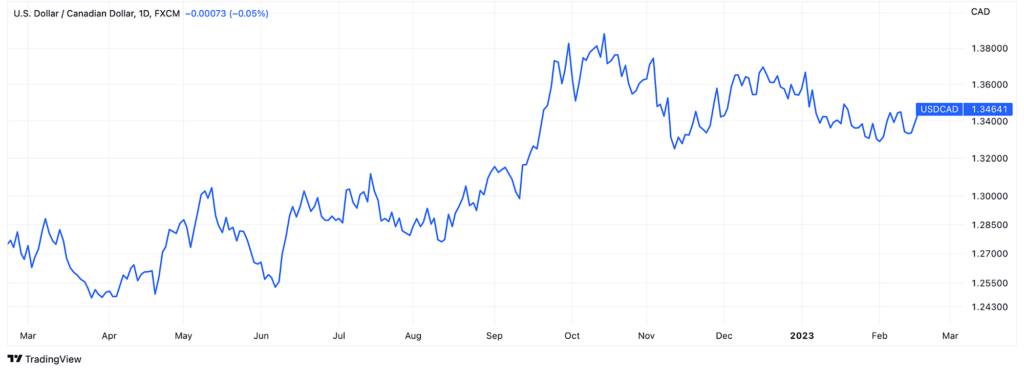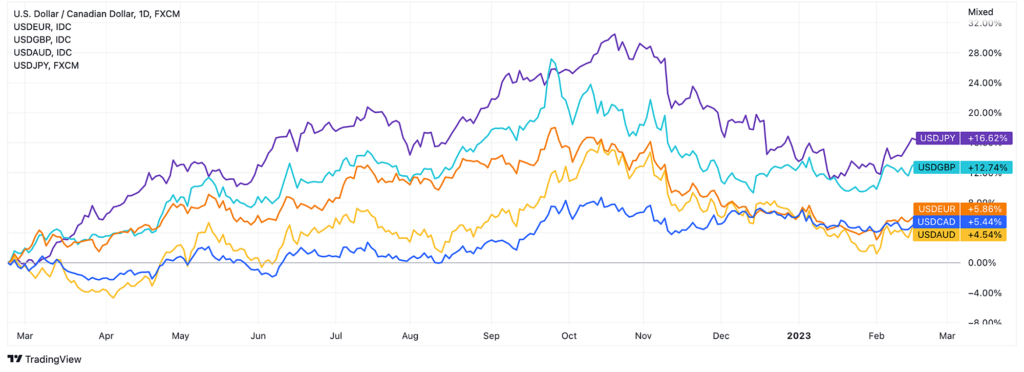Finance
Can The Canadian Dollar Recover Against The US Dollar?
The Bank of Canada announced a pause in raising interest rates and did it first among leading world central banks. Such a decision could only affect the Canadian dollar because we know that the key rate change is one of the most significant factors determining currency rate movements. So, does it mean that the future of the CAD in relation to the USD and other major currencies in 2023 is foggy? Or are there other drivers we haven’t taken into consideration yet?
First of all, let’s take a look at the chart representing what was going on with the USD/CAD currency pair last year. As you can see the current rate is 1.34 meaning that the US dollar has raised 5% in relation to the Canadian.

When comparing this result with other USD-based pairs, we see that the CAD has one of the best performances – only the Australian dollar is faring a little bit better.

A strong US dollar was one of the key trends of 2022. There were several reasons for that. The first one is the hawkish Fed policy. The American regulator hiked the key rate more aggressively than the others, and it made the USD extremely attractive for investors who always try to find more room for profitable deals. Lots of them draw on using various tools such as the US economic calendar – its main benefit keeping traders and investors up to date with the latest and upcoming market events including Fed’s activities, which consequently helps to forecast future rate movements.
At the same time, the global economic crisis led to a scenario where people were heavily investing in the US dollar as for many years it has been considered to be a “currency of refuge” – people around the globe have been buying greenbacks because they don’t perceive their local currency to be stable – the same can be said about stock and crypto market prospects.
By the beginning of 2023, the fortune turned away from USD and the balance tipped in the favor of other currencies, including CAD. The Fed is expected to take a break in hiking interest rates – so now the USD is less popular among investors. Plus, the unexpectedly warm winter in Europe and China’s zero-Covid policy relief turned up the heat on the US dollar rate as well. Taking all these events into account, there are more lucrative alternatives compared to the US dollar, which now seems to be the lesser choice.
Now let’s turn to the CAD. At the beginning of February, the Bank of Canada announced that they would stop pushing up interest rates. On the one hand, while other central banks keep raising the rates, the Canadian dollar will probably weaken. On the other hand, the central banks around the world are close to their maximum, and the moment they decide to suspend the key rate hike policy, the Canadian dollar will have a serious advantage over other currencies.
One more piece of good news for the “loonie” is the reopening of China after rigorous Covid restrictions. Canada is an exporter of different commodities. Therefore, the recovery of the Chinese economy will boost Canada’s export – and it will most likely be a growth driver for the CAD (albeit not as significant a growth driver as it is for the Australian dollar and some emerging countries currencies).
In general, the situation with the USD/CAD currency pair looks as though the USD will keep the 1.35 rate in the first half of 2023. But the closer it gets to the end of the year, the stronger the Canadian dollar must be. The rate can be around 1.30 or even 1.25.
However, do not forget that the state of the global affairs and forex market may change rather quickly. Whatever the analysts say could be instantly invalidated with another military conflict or calamity. So, before trading any asset, you should carry out your own in-depth analysis. As the old saying goes – better safe than sorry.